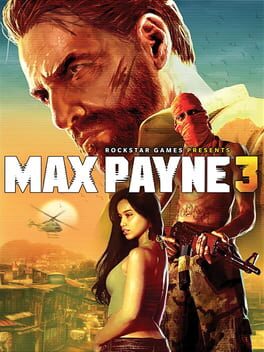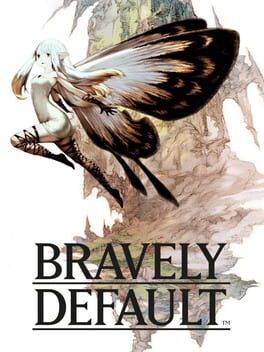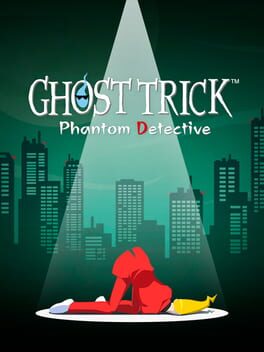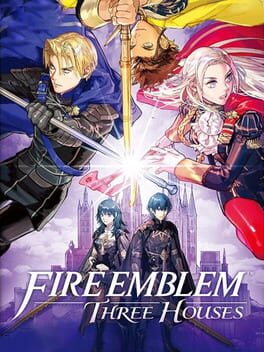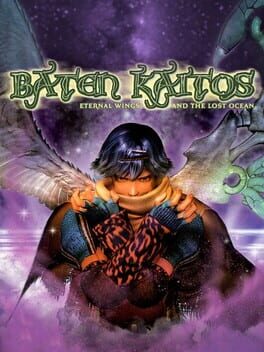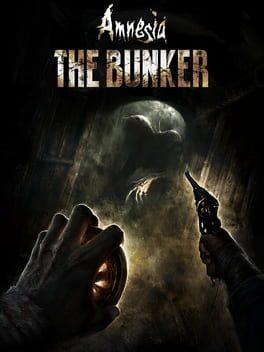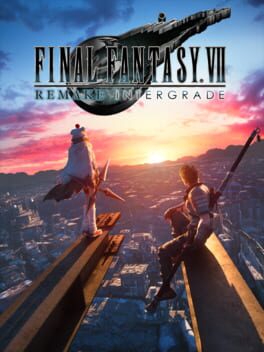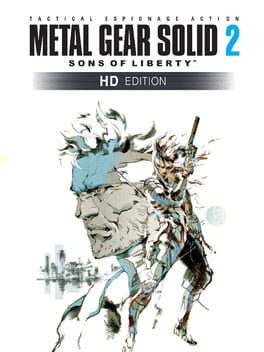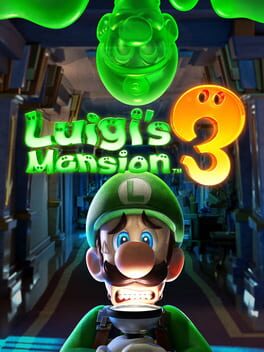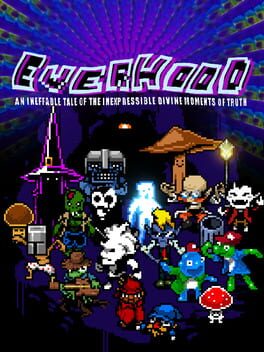Weepboop
BACKER
640 Reviews liked by Weepboop
Hi-Fi Rush
2023
As someone who adores action games, music, and vibrant colourful graphics, Hi-Fi Rush feels like a game that was made for me. It feels like something straight out of the early PS3 era and I do mean that in the best way possible.
Taking a lot of cues from character action and hack-and-slash titles, Hi-Fi Rush has a familiar feeling. Light and heavy attacks that can be strung together and spaced out for different combos, a dodge, a parry, a grapple, and a whole host of special meter moves. The twist here is that EVERYTHING in the game is in-time to the music. Your attacks and the enemy's attacks all line up to land on each beat of the song and you are encouraged to time your moves just right to master each encounter. It feels incredible if you can get into the groove of it, and almost everything makes a noise which indicates if you landed on or off beat to sync up to it. The only thing that doesn't, and perhaps my only major criticism of the game is the parry. You certainly hear and feel when you land a parry perfectly, but you don't get any feedback if your timing was too early or too late (outside of getting hit), so it took me quite a way through the game until I really felt comfortable with it.
That being said, multiple playthroughs are encouraged. There are no small number of secrets hidden in the gorgeous and thoughtfully designed levels, quite a few of which demand you come back later with all your upgrades/post-playthrough. Add in the scoring system for each encounter and level, and it's easy to see why you would want to play it over and over again.
As far as the story goes, it's serviceable for what it is. The strength is in the fun characters and writing, and I was really impressed with how much I loved the main character after my initial apprehension. The game also has a killer original soundtrack and even some well chosen licensed songs for a couple of the boss fights.
Hi-Fi Rush wraps up in a perfect length of around 10 hours, but as mentioned previously there are plenty of extras to look for after completing it. I highly recommend this game, and I am shocked that one of my favourite games of the year thus far just came out of nowhere. Well done to Tango Gameworks.
Taking a lot of cues from character action and hack-and-slash titles, Hi-Fi Rush has a familiar feeling. Light and heavy attacks that can be strung together and spaced out for different combos, a dodge, a parry, a grapple, and a whole host of special meter moves. The twist here is that EVERYTHING in the game is in-time to the music. Your attacks and the enemy's attacks all line up to land on each beat of the song and you are encouraged to time your moves just right to master each encounter. It feels incredible if you can get into the groove of it, and almost everything makes a noise which indicates if you landed on or off beat to sync up to it. The only thing that doesn't, and perhaps my only major criticism of the game is the parry. You certainly hear and feel when you land a parry perfectly, but you don't get any feedback if your timing was too early or too late (outside of getting hit), so it took me quite a way through the game until I really felt comfortable with it.
That being said, multiple playthroughs are encouraged. There are no small number of secrets hidden in the gorgeous and thoughtfully designed levels, quite a few of which demand you come back later with all your upgrades/post-playthrough. Add in the scoring system for each encounter and level, and it's easy to see why you would want to play it over and over again.
As far as the story goes, it's serviceable for what it is. The strength is in the fun characters and writing, and I was really impressed with how much I loved the main character after my initial apprehension. The game also has a killer original soundtrack and even some well chosen licensed songs for a couple of the boss fights.
Hi-Fi Rush wraps up in a perfect length of around 10 hours, but as mentioned previously there are plenty of extras to look for after completing it. I highly recommend this game, and I am shocked that one of my favourite games of the year thus far just came out of nowhere. Well done to Tango Gameworks.
Max Payne 3
2012
"Say what you want about Americans but we understand capitalism. You buy yourself a product and you get what you pay for, and these chumps had paid for some angry gringo without the sensibilities to know right from wrong."
'How I Spent my Summer Vacation' by Maxwell Payne
Rockstar's attempt at ending the Max Payne trilogy (so far) is one with an overabundance of flashy visual effects, sun-soaked debauchery, and the sharp, cynical storytelling that they're known for. You may not think that would work for a trilogy that thus far has been steeped in a dark noir atmosphere and perpetually set at night, but as it turns out, neo-noir can be just as compelling, if a little excessive.
Max Payne 3 is firmly a Rockstar game through and through, rather than their attempt at mimicking Remedy's sensibilities and design philosophy. For me, this distinction is largely for the better... save for a few key areas. For starters, the narrative and dialogue are both much sharper while still maintaining the staple over-descriptive narration.
The scope of Max Payne 1's story and the intimacy of Max Payne 2's are blended to great effect, throwing Max into the seedy underbelly of Sao Paulo, trying and failing to get away from his past mistakes yet finding them always close behind. It's compelling stuff and, at least to me, feels like a natural evolution (or de-volution in this case) of where the character would be later in life. I definitely favor this game's story over the other two, though I do prefer Rockstar's narrative playbook to Remedy's, in fairness.
As stated, the third entry trades the stylish graphic novel sequences for flashy editing complete with panel cuts, typography, and saturation effects to visualize Max losing his grip on sanity. They help to bring a unique style to the proceedings that makes Rockstar's take stand out while still remaining adjacent to the series's identity. While they do make cutscenes more fun and cinematic, they do start to wear out their welcome as they go on, especially as these effects sometimes interrupt gameplay.
The gunplay in particular receives a huge upgrade thanks to Rockstar's pedigree in TPS gameplay, at least at the time. The new bullet-cam is a little excessive and can get annoying, especially when you have multiple gunfights in a row. Which, to that point, are kind of in overabundance in this game. It's a Max Payne game after all, so like the man himself says, you do get what you pay for; however, it would have been nice to have more variety in the gameplay scenarios outside of a few vehicle-based segments. As it is, though, it's more akin to MP1's fondness for shooting gallery levels.
Max Payne 3 remains a very solid departure for the series, but one that still does its best to maintain the series's style and tropes regardless—an experiment that pays off mostly well, though I can certainly see why some may prefer the snow-covered streets of Noir York City in the first two to the crowded favelas of Sao Paulo in this entry.
7.5/10
'How I Spent my Summer Vacation' by Maxwell Payne
Rockstar's attempt at ending the Max Payne trilogy (so far) is one with an overabundance of flashy visual effects, sun-soaked debauchery, and the sharp, cynical storytelling that they're known for. You may not think that would work for a trilogy that thus far has been steeped in a dark noir atmosphere and perpetually set at night, but as it turns out, neo-noir can be just as compelling, if a little excessive.
Max Payne 3 is firmly a Rockstar game through and through, rather than their attempt at mimicking Remedy's sensibilities and design philosophy. For me, this distinction is largely for the better... save for a few key areas. For starters, the narrative and dialogue are both much sharper while still maintaining the staple over-descriptive narration.
The scope of Max Payne 1's story and the intimacy of Max Payne 2's are blended to great effect, throwing Max into the seedy underbelly of Sao Paulo, trying and failing to get away from his past mistakes yet finding them always close behind. It's compelling stuff and, at least to me, feels like a natural evolution (or de-volution in this case) of where the character would be later in life. I definitely favor this game's story over the other two, though I do prefer Rockstar's narrative playbook to Remedy's, in fairness.
As stated, the third entry trades the stylish graphic novel sequences for flashy editing complete with panel cuts, typography, and saturation effects to visualize Max losing his grip on sanity. They help to bring a unique style to the proceedings that makes Rockstar's take stand out while still remaining adjacent to the series's identity. While they do make cutscenes more fun and cinematic, they do start to wear out their welcome as they go on, especially as these effects sometimes interrupt gameplay.
The gunplay in particular receives a huge upgrade thanks to Rockstar's pedigree in TPS gameplay, at least at the time. The new bullet-cam is a little excessive and can get annoying, especially when you have multiple gunfights in a row. Which, to that point, are kind of in overabundance in this game. It's a Max Payne game after all, so like the man himself says, you do get what you pay for; however, it would have been nice to have more variety in the gameplay scenarios outside of a few vehicle-based segments. As it is, though, it's more akin to MP1's fondness for shooting gallery levels.
Max Payne 3 remains a very solid departure for the series, but one that still does its best to maintain the series's style and tropes regardless—an experiment that pays off mostly well, though I can certainly see why some may prefer the snow-covered streets of Noir York City in the first two to the crowded favelas of Sao Paulo in this entry.
7.5/10
Bravely Default
2013
This review contains spoilers
I love the job system in this game, the potential to set a secondary job moveset for every character, and select any unlockable ability from any job, not only encourages trying out multiple jobs on multiple characters, but ends up giving you so many ways to mix and match the traits from them. There's "only" 24 jobs in the game, but the decisions the game gives you for how to use the DNA of each job results in hundreds, or even thousands of combinations.
The titular mechanic adds a small bit of extra strategy, use bravely to risk a burst of power to end a boss fight, or even slice through mobs easily, or default to skip a turn but save the action for next turn, while acting as a regular block in an RPG. In fact even some classes are built on using turns for their move cost rather than MP or some such.
The soundtrack is fantastic, if a little repetitive.
Many of the towns look absolutely fantastic, though dungeons can be somewhat bland in appearance.
Gotta give the game credit for making the tedious part of JRPG's (grinding) so much more player friendly. Either the ability to set random encounter rate to 0, or the ability to fast forward battles and use "auto" mode, which will repeat the last actions each character was manually commanded. The latter includes the use of brave so you can just brave x4 attack everything with every character when going through generic enemies.
The story of the game is a way too close to how JRPG's are represented in basically any parody ever. Protagonist whose small childhood home was destroyed, with an obvious romantic connection to the leading female, who has a unique role in this worlds religion. Story is centred around crystals. Last boss is some kind of universe-destroying being. It's all some of the most derivative plot I've ever seen.
Luckily the characters make it all worth sitting through. I enjoyedall most of them. And each job even has a corresponding villain, each with a memorable personality and a variety of roles in the story. The biggest problem I had with the characters was the 2 who spent 90% of their dialogue being perverts. Luckily this trait does kind of fade away as the stakes are raised, but it takes way too long. What really saves them is the fact that both of these characters have some of the better backstories in the game.
The elephant in the room is the Groundhog Day portion of the game. In theory I think it would be fun, but they do so little with the idea. Every old boss is fightable again as a side-quest during these portions, but there's only very brief dialogue that changes how these encounters happened the first time, and by the third loop sometimes they don't even change the dialogue at all, and your player characters are reacting in shock to things they've already been told 2 loops ago. Loops 4 and 5 do change things up a bit more by moving the bosses around and teaming them up together, but that mostly just results in a small cutscene where you get to see charatcers interacting who never did so in the first part of the game, and then a harder than usual boss fight. Not the worst extra content, but it really shouldn't have been 4 extra rewinds long just for that.
At least if you don't care about these optional rematches you can do the entire section in just a few hours, with the main story beats at least offering more palpable progress. It's pretty much due to this that I didn't lower the rating any more, because I could honestly have given the game a 10 at first, even with its unoriginal story, I found the rest of the game extremely fun and addicting. But the latter half was too drawn out and did way too little with the concept.
The titular mechanic adds a small bit of extra strategy, use bravely to risk a burst of power to end a boss fight, or even slice through mobs easily, or default to skip a turn but save the action for next turn, while acting as a regular block in an RPG. In fact even some classes are built on using turns for their move cost rather than MP or some such.
The soundtrack is fantastic, if a little repetitive.
Many of the towns look absolutely fantastic, though dungeons can be somewhat bland in appearance.
Gotta give the game credit for making the tedious part of JRPG's (grinding) so much more player friendly. Either the ability to set random encounter rate to 0, or the ability to fast forward battles and use "auto" mode, which will repeat the last actions each character was manually commanded. The latter includes the use of brave so you can just brave x4 attack everything with every character when going through generic enemies.
The story of the game is a way too close to how JRPG's are represented in basically any parody ever. Protagonist whose small childhood home was destroyed, with an obvious romantic connection to the leading female, who has a unique role in this worlds religion. Story is centred around crystals. Last boss is some kind of universe-destroying being. It's all some of the most derivative plot I've ever seen.
Luckily the characters make it all worth sitting through. I enjoyed
The elephant in the room is the Groundhog Day portion of the game. In theory I think it would be fun, but they do so little with the idea. Every old boss is fightable again as a side-quest during these portions, but there's only very brief dialogue that changes how these encounters happened the first time, and by the third loop sometimes they don't even change the dialogue at all, and your player characters are reacting in shock to things they've already been told 2 loops ago. Loops 4 and 5 do change things up a bit more by moving the bosses around and teaming them up together, but that mostly just results in a small cutscene where you get to see charatcers interacting who never did so in the first part of the game, and then a harder than usual boss fight. Not the worst extra content, but it really shouldn't have been 4 extra rewinds long just for that.
At least if you don't care about these optional rematches you can do the entire section in just a few hours, with the main story beats at least offering more palpable progress. It's pretty much due to this that I didn't lower the rating any more, because I could honestly have given the game a 10 at first, even with its unoriginal story, I found the rest of the game extremely fun and addicting. But the latter half was too drawn out and did way too little with the concept.
Final Fantasy XVI
2023
An experience that takes a 'different' direction without taking away from the franchise
The combat for this title is incredible, I finished the game with 66 hours of playtime and was still discovering new things you could do with the action. The way the different Eikons work makes the experience fresh, with its unique feats. Boss fights will pull you in with the insane action, with some exciting sequence breaks between them to invoke excitement, and find no boss except 1 to be underwhelming.
The Eikon battles were a big part of the marketing of this game and I found they did not disappoint the sheer scale of them draws you in as you experience pure spectacle.
Now the story and characters in this title drew me in, I love the cast and this carried over when I completed all the side quests within the game, the characters are fascinating. An example of this is a specific side character's placement within the world of Valisthea and how side quests allowed you to learn more about them naturally without needing the power of a story DLC to do so. Speaking more specifically about the side quests is that they only truly start to kick off during the second half of the game, where their impact starts to break out of a compressed circle and can influence even the whole world. The main story can be bad in pacing sometimes, making you have to do the most monotonous of activities when you are at an exciting point, but overall is a strong narrative.
However, I didn't like how the ending was left to interpretation, I completed all the side quests that provided more groundwork in doing that but still left me yearning for a more clear conclusion
Overall I love this title so much and struggle to see another game take its place as my GOTY, I have taken half a rating away because the destination of the story did not really do it for me but in terms of a game, it will measure up to many hours of fun. I will definitely be doing New Game + to conquer that platinum trophy
July 30th Update:
Never mind I think this game is a masterpiece and the ending has grown on me.
The combat for this title is incredible, I finished the game with 66 hours of playtime and was still discovering new things you could do with the action. The way the different Eikons work makes the experience fresh, with its unique feats. Boss fights will pull you in with the insane action, with some exciting sequence breaks between them to invoke excitement, and find no boss except 1 to be underwhelming.
The Eikon battles were a big part of the marketing of this game and I found they did not disappoint the sheer scale of them draws you in as you experience pure spectacle.
Now the story and characters in this title drew me in, I love the cast and this carried over when I completed all the side quests within the game, the characters are fascinating. An example of this is a specific side character's placement within the world of Valisthea and how side quests allowed you to learn more about them naturally without needing the power of a story DLC to do so. Speaking more specifically about the side quests is that they only truly start to kick off during the second half of the game, where their impact starts to break out of a compressed circle and can influence even the whole world. The main story can be bad in pacing sometimes, making you have to do the most monotonous of activities when you are at an exciting point, but overall is a strong narrative.
However, I didn't like how the ending was left to interpretation, I completed all the side quests that provided more groundwork in doing that but still left me yearning for a more clear conclusion
Overall I love this title so much and struggle to see another game take its place as my GOTY, I have taken half a rating away because the destination of the story did not really do it for me but in terms of a game, it will measure up to many hours of fun. I will definitely be doing New Game + to conquer that platinum trophy
July 30th Update:
Never mind I think this game is a masterpiece and the ending has grown on me.
An absolutely fantastic game with an amazing lore, solid characters, and just the right amount of grey in the setting without going overboard and ending up pretentious.
It's an almost 5 stars, hampered by the stupid decision of making the diverging choice to plsy the different campaigns at the beginning, rather than the middle, forcing you to replay White Clouds at least 3 times, with the missions being the same each time.
Other than that this is a masterpiece
It's an almost 5 stars, hampered by the stupid decision of making the diverging choice to plsy the different campaigns at the beginning, rather than the middle, forcing you to replay White Clouds at least 3 times, with the missions being the same each time.
Other than that this is a masterpiece
Steins;Gate
2009
A time travel fiction that is strong enough to reach its peak quality.
As someone who watched the anime first, a pretty long part of the playthrough was boring, but just like when I watched it, when it starts, it starts.
There is no gameplay, a pure visual novel by the definition of the word. Flowcharts are made by your replies (or not) to specific emails, at specific times.
But this does not reduce the quality of writing in any way. Time travel is so good, it has consequences, it has rules, it has SUFFERING, AND I LIKE THAT. (sorry)
The only flaw is definitely half of it being extremely slow and annoying because nothing happens, but like I said, when it gets there, it'll get you. If you like heavy story-based games, open the steins gate!
El Psy Kongroo.
As someone who watched the anime first, a pretty long part of the playthrough was boring, but just like when I watched it, when it starts, it starts.
There is no gameplay, a pure visual novel by the definition of the word. Flowcharts are made by your replies (or not) to specific emails, at specific times.
But this does not reduce the quality of writing in any way. Time travel is so good, it has consequences, it has rules, it has SUFFERING, AND I LIKE THAT. (sorry)
The only flaw is definitely half of it being extremely slow and annoying because nothing happens, but like I said, when it gets there, it'll get you. If you like heavy story-based games, open the steins gate!
El Psy Kongroo.
Amnesia: The Bunker
2023
Honestly was iffy on yet another Amnesia game after Rebirth, especially given this one seemed to forgo the narrative focus of the series for something akin to an immersive sim style which wasn’t sure if they’d execute well. But while different and smaller scaled I liked this one too, in fact of the three it’s probably the most interesting from a gameplay standpoint
For one it’s actually pretty scary unlike Rebirth. You’re being hunted by a monster with AI akin to the unpredictability seen in Alien: Isolation, and the atmosphere/sound of the WWI bunker as you try and explore is constantly oppressive. On top of that, you need to find fuel in order to keep a single generator running that’s your only source of power, as the bunker goes pitch dark when it’s off and the monster starts roaming more freely. It works well and makes for a tense race to gather what you can before the lights go out
The bunker has various areas to explore in order to find items you’ll need to escape, along with notes that can help you around or gives info on the bunker and its (prior) inhabitants. You’re also free to go where you wish and have various options to get through barriers (like locked doors that can be broken through in different ways). Items are also randomized each playthrough which is a neat way to add more replayability to it
It’s not very lengthy (finished at about 4 hours), but was cool and shows Frictional still has ideas that can help liven up their usual formula going forward. Definitely looking forward to their next project, hopefully it’s a new IP though
For one it’s actually pretty scary unlike Rebirth. You’re being hunted by a monster with AI akin to the unpredictability seen in Alien: Isolation, and the atmosphere/sound of the WWI bunker as you try and explore is constantly oppressive. On top of that, you need to find fuel in order to keep a single generator running that’s your only source of power, as the bunker goes pitch dark when it’s off and the monster starts roaming more freely. It works well and makes for a tense race to gather what you can before the lights go out
The bunker has various areas to explore in order to find items you’ll need to escape, along with notes that can help you around or gives info on the bunker and its (prior) inhabitants. You’re also free to go where you wish and have various options to get through barriers (like locked doors that can be broken through in different ways). Items are also randomized each playthrough which is a neat way to add more replayability to it
It’s not very lengthy (finished at about 4 hours), but was cool and shows Frictional still has ideas that can help liven up their usual formula going forward. Definitely looking forward to their next project, hopefully it’s a new IP though
I don't even know where to begin with this.
This was one of the most batshit crazy gaming experiences I've ever had. Every time I thought the story couldn't possibly get any more unhinged, Hideo Kojima surprised me by making this shit even more insane. And I absolutely loved every minute of it.
MGS2 really improved the gameplay for me in a lot of ways. The controls felt smoother compared to MGS1, and I appreciated the myriad of ways you could approach each encounter that didn't rely on strictly stealth or combat. Despite the fact that MGS2 has a limited setting(s), I really enjoyed the environmental design of the levels, and found the AI this time to be much more of a challenge.
And holy shit, this story. I love how it gradually unspools itself into this complex interwoven clusterfuck that doesn't let up until the credits roll. I've read a lot about how this game predicted a lot of the shit we deal with now in 2023, and I do have to say that it is eerily prescient. Kojima is a genius, plain and simple, and the fact that he created this story in 2001 (and more likely before that since 2001 is when it was released) is mind blowing.
MGS2 has catapulted itself into my all-time favorite games, and I can't believe I'm just now getting around to this series as a whole. This was such a masterpiece, and I'm so hyped to continue with MGS3.
This was one of the most batshit crazy gaming experiences I've ever had. Every time I thought the story couldn't possibly get any more unhinged, Hideo Kojima surprised me by making this shit even more insane. And I absolutely loved every minute of it.
MGS2 really improved the gameplay for me in a lot of ways. The controls felt smoother compared to MGS1, and I appreciated the myriad of ways you could approach each encounter that didn't rely on strictly stealth or combat. Despite the fact that MGS2 has a limited setting(s), I really enjoyed the environmental design of the levels, and found the AI this time to be much more of a challenge.
And holy shit, this story. I love how it gradually unspools itself into this complex interwoven clusterfuck that doesn't let up until the credits roll. I've read a lot about how this game predicted a lot of the shit we deal with now in 2023, and I do have to say that it is eerily prescient. Kojima is a genius, plain and simple, and the fact that he created this story in 2001 (and more likely before that since 2001 is when it was released) is mind blowing.
MGS2 has catapulted itself into my all-time favorite games, and I can't believe I'm just now getting around to this series as a whole. This was such a masterpiece, and I'm so hyped to continue with MGS3.
Elden Ring
2022
Elden Ring is truly a masterpiece from FromSoftware.
The open world is breathtaking and offers an enjoyable exploration experience, even for someone like me who isn't a big fan of aimless wandering. However, I found the open world dungeons to be somewhat disappointing as they all are identical. The main ones are good.
While it's true that some of the bosses are repeated throughout the game, the unique ones feature amazing fights and cool designs. Except for Malenia, who is just awful.
As someone who isn't the biggest Souls fanboy, I don't have much to say about this game. I do believe that Bloodborne only looses in comparison due to the tedious process of running back to a boss fight. Thankfully, Elden Ring does not have that backtracking, which was a relief for some hard bosses.
While Elden Ring may not be the best game of the century or even of recent years, it is still an exceptional game that will keep you hooked for more than 60 hours. Again, only a Souls Like to make you addicted to the dopamine rush of endless retries and eventually wins it provides.
The open world is breathtaking and offers an enjoyable exploration experience, even for someone like me who isn't a big fan of aimless wandering. However, I found the open world dungeons to be somewhat disappointing as they all are identical. The main ones are good.
While it's true that some of the bosses are repeated throughout the game, the unique ones feature amazing fights and cool designs. Except for Malenia, who is just awful.
As someone who isn't the biggest Souls fanboy, I don't have much to say about this game. I do believe that Bloodborne only looses in comparison due to the tedious process of running back to a boss fight. Thankfully, Elden Ring does not have that backtracking, which was a relief for some hard bosses.
While Elden Ring may not be the best game of the century or even of recent years, it is still an exceptional game that will keep you hooked for more than 60 hours. Again, only a Souls Like to make you addicted to the dopamine rush of endless retries and eventually wins it provides.
Luigi's Mansion 3
2019
This review contains spoilers
The hotel in Luigi's Mansion 3 doesn't really start out all that special. The first 4 or 5 floors you'll explore really are just a haunted hotel. The bosses are so vanilla and simple that I honestly didn't even realise the first 2 bosses I fought were bosses. It was an almost return to form, removing those more Mario-styled themed settings in favour of a kid-friendly horror game in an actual place.
Then we get to the music floor, and from that point onwards every single floor in the game is unashamedly a theme park attraction with every room on the floor being decorated like a museum, or a beach, or a music club. And the bosses creativity ramp up in just as drastically and consistently.
Whether this change is good or bad is obviously subjective. I like the straight spooky vibe of the original game, but I don't know how well they could have managed a 17-floor hotel like that. Personally I loved looking forward to seeing what crazy aesthetic the next level would take.
One thing I had heard a lot of about this game was that it brought back the portrait ghosts, which is only 30% true. At least for what I considered portrait ghosts, which was much more human-looking ghosts that felt like they really were people who died at one point. The "portrait ghosts" in this game (actually called boss ghosts) are a little more detailed than the average regular enemy, but still feel very cartoony and blend into the fantasy world much more naturally. And that's when they're actually human, some bosses possess things (think similar to Luigi's Mansion 2 boss fights) and one of them, even in base form, is a pirate shark.
But don't get me wrong, while I absolutely love the creepy vibe the original portrait ghosts gave off, there's no doubt that the boss battles in this game were by far the best in the series. After that initial few floors of very simple battles, every boss in this game is full of clever ideas and fun use of their theming. It's something I'm not sure you could accomplish if they did go for the more realistic approach of their designs.
In terms of gameplay this seems to be a lot more puzzle focused than before. Having the full Poltergust arsenal of the last game, along with new additions like the plunger and whatever the "shockwave" move is called add even more layers to interacting with the environment. Though weirdly, after Dark Moon removed elements from Luigi's Vacuum, and just had environmental fire puzzles scattered all over, this game further removes almost any trace of elemental stuff at all except for maybe one or two small fire based stuff.
Controls can be a bit awkward though. Using face buttons for most things is generally harder since you can't naturally use the right joy stick while pressing the buttons. Luckily the game offers the use of shoulder buttons to do pretty much any action you can do with those face buttons. But to use the light-dark light you need to press L+R together, but with a timing so awkward that it often just has you using the plunger (L) instead. I get that there's only so many combinations you can add to the shoulder buttons, but why is a function that has you constantly spinning around the room to search for hidden objects relegated to this double button press, rather than the plunger which generally just has you aim in one direction and shoot? And there's no button remapping!
Also speaking of controls, there's no dedicated run button now. Luigi just starts running faster after a couple seconds of build up. Not really the worst thing, but why? The B button isn't doing anything except allowing you to move with the left joystick without actually turning Luigi around. Maybe someone found this useful, but personally I'm not sure I ever found myself wanting Luigi to walk backwards while facing forwards.
The power of the vacuum has seemingly improved a lot too. It'll now be able to devour anything the size of a small dog, which lets you tear through rooms. Going to town on a whole shelf worth of random junk feels so satisfying.
Likewise the "press A to suck in ghosts faster" function from the second game returns, but now instead of just draining a lot of the ghosts health at once, you get to literally slam the ghost around for a few A presses at a time before they die or break loose. It is so much fun to slam ghosts into other ghosts, or even just the environment to destroy tables and the like.
I can't go without giving props to the incredible graphics and animations in this game. I'm not sure the Mario-verse have ever been so expressive.
As for Gooigi, I was initially worried that a mechanic that seemed designed for co-op would be a huge pain in the ass for single player, but I think they managed it well. I can't say for sure having not played co-op, but it feels like they balanced him around single player, and I guess just made co-op easy mode.
Not for the first time in recent memory I have to talk about collectables. This game features the exact same ones as Luigi's Mansion 2 - Boo's, Gems and Cash. The first 2 literally only give you a small aesthetic change to one of your Poltergust functions and only when you've collected 100% of them, so you'll literally only be able to change your plunger to a crystal skin in the final 10 minutes of the game. Yay?
But the cash is what baffles me the most. In Luigi's Mansion 2 money was used to get periodic upgrades to your equipment and was used as part of calculating your rank for each level. In this game there are no upgrades (except for anything you get automatically as part of the story), instead there's a store for money, in which you can buy...bonus lives (the same golden bones you got in Dark Moon, but which in that game were found by searching objects after getting 200 coins in a level), or hints as to where to find a Boo or Gem. They're pretty lacklustre options, especially as the main use is for completionists only. Except... money is also used in this game to calculate your overall rank at the end, like in the first game. And it only counts the money on hand at the end of the game, so any money spent is not counted.
That means the only thing you can really spend money on, except for bonus lives if you're really bad at the game, is stuff that helps you collect everything, but saving money is also important for getting that arbitrary top rank which would count as a completion criteria for most people who care about getting all gems and Boo's in the first place. Do you see the problem here? Why do the only 2 uses for money in this game work completely against each other??
Also I know that getting an ending rank was the only purpose of it in Luigi's Mansion 1 too, but there's some huge differences. That game was very short, so it was easier to do a run where you decide to get as much gold as you can without getting fatigued. Sure getting "A rank" isn't an amazing reward, but for a small amount of extra effort in a 5 hour game, it's fine. But also money in the first game is almost always just naturally thrown into the main ghost catching quest. There's like half a dozen times I can think of where you have to go out of your way to get large amounts of money. In this game there are so many puzzles and even full rooms that only really exist to give you more money. You spend probably 70% of your time in this game exclusively sucking things up to find money, solving puzzles to find money or otherwise gems (assuming you don't just skip past every non-mandatory thing).
I realise this is a lot of paragraphs for an issue that barely registers to most people, but it's just a design decision that makes no sense to me. You'd think between this being a longer game, and so much of the dev time being put into making hiding spots for $$$$ that they'd give you more use for it than a letter at the end. They could have made your Poltergust stronger at certain milestones like the last game, or even just extra costumes for Luigi's or something.
But with that long, yet small issue out the way I still loved the game and have mostly just praise for it.
I'd say it's a hard decision if I were to pick between this or the original as my favourite. This one definitely has by far more ideas and bells and whistles, but the original just had a tone that feels unbeatable in a very tight package. Luigi's Mansion 1 feels like an anomaly in the Mario franchise, something that doesn't fit the franchises image. This game (or I guess technically the second, with this expanding on it) takes the idea of Luigi's Mansion and fits it into Mario's world. Both are fantastic for different reasons.
Then we get to the music floor, and from that point onwards every single floor in the game is unashamedly a theme park attraction with every room on the floor being decorated like a museum, or a beach, or a music club. And the bosses creativity ramp up in just as drastically and consistently.
Whether this change is good or bad is obviously subjective. I like the straight spooky vibe of the original game, but I don't know how well they could have managed a 17-floor hotel like that. Personally I loved looking forward to seeing what crazy aesthetic the next level would take.
One thing I had heard a lot of about this game was that it brought back the portrait ghosts, which is only 30% true. At least for what I considered portrait ghosts, which was much more human-looking ghosts that felt like they really were people who died at one point. The "portrait ghosts" in this game (actually called boss ghosts) are a little more detailed than the average regular enemy, but still feel very cartoony and blend into the fantasy world much more naturally. And that's when they're actually human, some bosses possess things (think similar to Luigi's Mansion 2 boss fights) and one of them, even in base form, is a pirate shark.
But don't get me wrong, while I absolutely love the creepy vibe the original portrait ghosts gave off, there's no doubt that the boss battles in this game were by far the best in the series. After that initial few floors of very simple battles, every boss in this game is full of clever ideas and fun use of their theming. It's something I'm not sure you could accomplish if they did go for the more realistic approach of their designs.
In terms of gameplay this seems to be a lot more puzzle focused than before. Having the full Poltergust arsenal of the last game, along with new additions like the plunger and whatever the "shockwave" move is called add even more layers to interacting with the environment. Though weirdly, after Dark Moon removed elements from Luigi's Vacuum, and just had environmental fire puzzles scattered all over, this game further removes almost any trace of elemental stuff at all except for maybe one or two small fire based stuff.
Controls can be a bit awkward though. Using face buttons for most things is generally harder since you can't naturally use the right joy stick while pressing the buttons. Luckily the game offers the use of shoulder buttons to do pretty much any action you can do with those face buttons. But to use the light-dark light you need to press L+R together, but with a timing so awkward that it often just has you using the plunger (L) instead. I get that there's only so many combinations you can add to the shoulder buttons, but why is a function that has you constantly spinning around the room to search for hidden objects relegated to this double button press, rather than the plunger which generally just has you aim in one direction and shoot? And there's no button remapping!
Also speaking of controls, there's no dedicated run button now. Luigi just starts running faster after a couple seconds of build up. Not really the worst thing, but why? The B button isn't doing anything except allowing you to move with the left joystick without actually turning Luigi around. Maybe someone found this useful, but personally I'm not sure I ever found myself wanting Luigi to walk backwards while facing forwards.
The power of the vacuum has seemingly improved a lot too. It'll now be able to devour anything the size of a small dog, which lets you tear through rooms. Going to town on a whole shelf worth of random junk feels so satisfying.
Likewise the "press A to suck in ghosts faster" function from the second game returns, but now instead of just draining a lot of the ghosts health at once, you get to literally slam the ghost around for a few A presses at a time before they die or break loose. It is so much fun to slam ghosts into other ghosts, or even just the environment to destroy tables and the like.
I can't go without giving props to the incredible graphics and animations in this game. I'm not sure the Mario-verse have ever been so expressive.
As for Gooigi, I was initially worried that a mechanic that seemed designed for co-op would be a huge pain in the ass for single player, but I think they managed it well. I can't say for sure having not played co-op, but it feels like they balanced him around single player, and I guess just made co-op easy mode.
Not for the first time in recent memory I have to talk about collectables. This game features the exact same ones as Luigi's Mansion 2 - Boo's, Gems and Cash. The first 2 literally only give you a small aesthetic change to one of your Poltergust functions and only when you've collected 100% of them, so you'll literally only be able to change your plunger to a crystal skin in the final 10 minutes of the game. Yay?
But the cash is what baffles me the most. In Luigi's Mansion 2 money was used to get periodic upgrades to your equipment and was used as part of calculating your rank for each level. In this game there are no upgrades (except for anything you get automatically as part of the story), instead there's a store for money, in which you can buy...bonus lives (the same golden bones you got in Dark Moon, but which in that game were found by searching objects after getting 200 coins in a level), or hints as to where to find a Boo or Gem. They're pretty lacklustre options, especially as the main use is for completionists only. Except... money is also used in this game to calculate your overall rank at the end, like in the first game. And it only counts the money on hand at the end of the game, so any money spent is not counted.
That means the only thing you can really spend money on, except for bonus lives if you're really bad at the game, is stuff that helps you collect everything, but saving money is also important for getting that arbitrary top rank which would count as a completion criteria for most people who care about getting all gems and Boo's in the first place. Do you see the problem here? Why do the only 2 uses for money in this game work completely against each other??
Also I know that getting an ending rank was the only purpose of it in Luigi's Mansion 1 too, but there's some huge differences. That game was very short, so it was easier to do a run where you decide to get as much gold as you can without getting fatigued. Sure getting "A rank" isn't an amazing reward, but for a small amount of extra effort in a 5 hour game, it's fine. But also money in the first game is almost always just naturally thrown into the main ghost catching quest. There's like half a dozen times I can think of where you have to go out of your way to get large amounts of money. In this game there are so many puzzles and even full rooms that only really exist to give you more money. You spend probably 70% of your time in this game exclusively sucking things up to find money, solving puzzles to find money or otherwise gems (assuming you don't just skip past every non-mandatory thing).
I realise this is a lot of paragraphs for an issue that barely registers to most people, but it's just a design decision that makes no sense to me. You'd think between this being a longer game, and so much of the dev time being put into making hiding spots for $$$$ that they'd give you more use for it than a letter at the end. They could have made your Poltergust stronger at certain milestones like the last game, or even just extra costumes for Luigi's or something.
But with that long, yet small issue out the way I still loved the game and have mostly just praise for it.
I'd say it's a hard decision if I were to pick between this or the original as my favourite. This one definitely has by far more ideas and bells and whistles, but the original just had a tone that feels unbeatable in a very tight package. Luigi's Mansion 1 feels like an anomaly in the Mario franchise, something that doesn't fit the franchises image. This game (or I guess technically the second, with this expanding on it) takes the idea of Luigi's Mansion and fits it into Mario's world. Both are fantastic for different reasons.
Everhood
2021
Pros:
- The awesome rhythm style combat’s what really makes Everhood stand out, enemies very quickly get over the top but the presentation and music are phenomenal, getting even better as it goes when you unlock the mechanic to deflect attacks
- Great use of psychedelic visuals and black backgrounds
- Awesome ending and fun optional boss fights
Cons:
- Perhaps a bit too inspired by Undertale, though I didn't really mind this myself
- This is specific to the Switch version but load times are frequent and could get very long on there, sometimes would wonder if the game crashed cause it would just sit on a black screen for 20 seconds. Would recommend playing on PC or PlayStation/Xbox instead
- The awesome rhythm style combat’s what really makes Everhood stand out, enemies very quickly get over the top but the presentation and music are phenomenal, getting even better as it goes when you unlock the mechanic to deflect attacks
- Great use of psychedelic visuals and black backgrounds
- Awesome ending and fun optional boss fights
Cons:
- Perhaps a bit too inspired by Undertale, though I didn't really mind this myself
- This is specific to the Switch version but load times are frequent and could get very long on there, sometimes would wonder if the game crashed cause it would just sit on a black screen for 20 seconds. Would recommend playing on PC or PlayStation/Xbox instead

